Nori in Swansea and a forgotten phycologist
The centrepiece of Swansea indoor market is a pentagon of seafood stalls all selling the products of the local shoreline, chiefly cockles and laver. Known in Japan as nori, laver is a seaweed of the genus Porphyra that has been harvested on the SW Wales coast for centuries. It was traditionally women's work to collect the raw product, boil it down to an edible mush and take it to market in pony panniers to sell as laverbread - mixed with oatmeal and formed into patties it's fried with bacon for breakfast. This remains popular today but the same stuff is also being used in other ways as a consequence of the popularity of Japanese cuisine which uses nori as a sushi wrapper in particular.
All the seaweed sellers in Swansea market are still women, there's never a man serving on these stalls. And if it were not for a woman nori might not be the internationally important commercial product it is now. Kathleen Drew-Baker, born 117 years ago today in Lancashire, was a phycologist [not a typo, it's a biologist who studies algae] who, despite losing her Manchester university post because she got married, independently discovered hitherto unknown information about the lifecycle of Porphyra in particular the fact that in its embryonic form it colonises shellfish. As a result Japan's failing seaweed cultivation was revived and became a massive industry. To this day Drew-Baker is revered in Japan where she is commemorated with a monument, an annual festival and the soubriquet 'Mother of the Sea'. Elsewhere she's another overlooked and under-rated female scientist.
Remembering you on your birthday Kathleen!
Read about her here (NB incorrectly states laver is a North Wales thing - it's not.)
A closer look at laverbread in extra


Comments
Sign in or get an account to comment.


